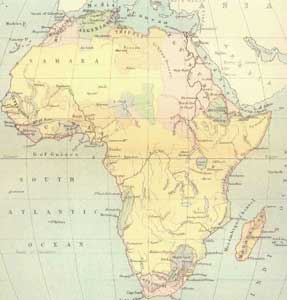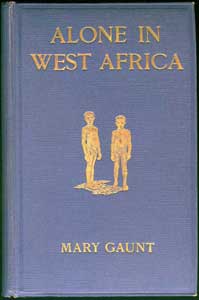| UCLA Library Special Collections |
 |
|
NINETEENTH-CENTURY
LADY TRAVELERS IN AFRICA Women
travelers to Africa were true explorer-adventurers, willing
to undertake long, dangerous journeys to remote places at
considerable risk to themselves. In doing so, they saw themselves
as equal participants in the tradition of nineteenth-century
male exploration. Kingsley spoke of “the school of
travelers of which Du Chaillu, Dr. Barth, Joseph Thomson
and Livingston are past masters and of which I am a humble
member.” These women’s achievements were considerable,
most notably, Sheldon’s exploration of Lake Chala,
on the slopes of Mount Kilamanjaro, and Kingsley’s
surveys of the Ogowé and the Rembwé Rivers
in West Africa.
|

 |
|
|
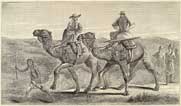 |
|
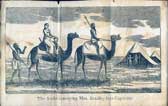 |
| May
French Sheldon (1848-1936)
Sheldon, born in Boston,
is the most eccentric lady traveler. She explored the East
African desert in an elaborate wicker palanquin (of her
own design), wearing gowns (and sometimes a blonde wig),
with enough baggage to require a retinue of 100 porters.
She was also the author of a best selling novel, Herbert
Severance, and the translator of Flaubert’s Salammbo.
Her work on the previously unexplored Lake Chala led her
(along with Bird and Marsden) to be one of the first women
elected into fellowship of the Royal Geographic Society
in 1892.
|
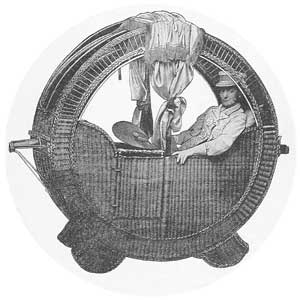
May French Sheldon.
Sultan to Sultan: Adventures among the Masai and other
tribes of East Africa. London: Saxon & Co., 1892.
Frontispiece. |
|
Mary Gaunt (1872-1942)
Mary Gaunt, novelist and travel writer,
is the most famous Australian lady traveler. She swung her
way through the Gold Coast of Africa in a hammock, carried
by native men. Her particular interest was describing the
domestic life and social customs of the African peoples
she encountered. Like Mary Kingsley, she was critical of
missionary methods and of pre-War British imperialist attitudes.
|
| Florence and Samuel Baker
– ‘Lovers on the Nile’
Florence von Sass was a seventeen-year
old, about to be sold into bondage at a slave market in
Hungary, when recently widowed English explorer, Sir Samuel
Baker, rescued her. She participated in both of his African
expeditions to Abyssinia (Ethiopia), one to find the source
of the Nile, and the second to thwart the slave trade. Though
they traveled as man and wife, they did not marry until
their return to England in 1865; this hint of scandal caused
Florence to be unjustly ostracized by some members of London
society. She was a loyal, brave and resourceful partner.
Samuel wrote that she had “a share of sang-froid admirably
adapted for African travel. Mrs. Baker is not a screamer.”
|
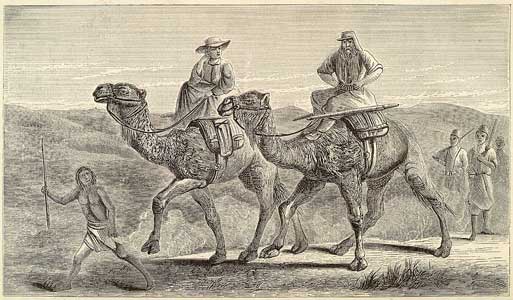
Illustration from Samuel
Baker,Exploration of the Nile tributaries of Abyssinia.
(London: Macmillan and Co., 1867). |
| 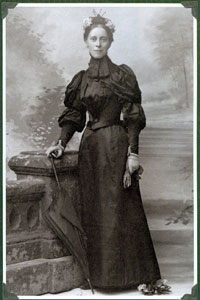
Mary
Kingsley. West African Studies. London: Macmillan
and Co., 1899. |
Mary Kingsley
(1862-1900)
Kingsley, insisting that “you
have no right to go about Africa in things you would be
ashamed of at home,” waded through West African swamps
and rivers in Victorian drawing room dress. She made two
trips to Sierra Leone where she became the first westerner
to survey the upper reaches of the Ogowé River. She
was also a self-educated naturalist who discovered several
unknown species and a dedicated spokesman on behalf of tribal
Africans.
|
KIDNAPPINGS
ON THE BARBARY COAST
From the sixteenth to the nineteenth
centuries, the Barbary pirates (based in Algiers and Tunis)
terrorized the seas surrounding northern Africa and the
shores of Europe opposite. At the height of their powers,
in the mid-seventeenth century, they carried off the entire
Irish town of Baltimore; 20,000 slaves were said to be imprisoned
in Algiers alone at the time. Although piracy declined somewhat
in the eighteenth century, kidnapping by Corsairs remained
a risk of sea travel in these regions, especially for women.
Marsh was kidnapped in 1756, and in 1776, Aimée Dubucq
de Rivery, the “French Sultana,” mother of Sultan
Mahmoud II, was abducted from a ship sailing from Nantes
to Martinique (described by Lesley Blanch in her book, The
Wilder Shores of Love). Of those taken captive, the
rich were frequently allowed to redeem themselves; the poor
were condemned to slavery.
|
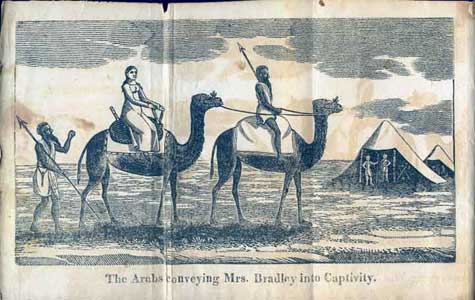
Eliza Bradley. An
Authentic Narrative of the Shipwreck and Sufferings of Mrs.
Eliza Bradley. Boston: James Walden, 1820. |
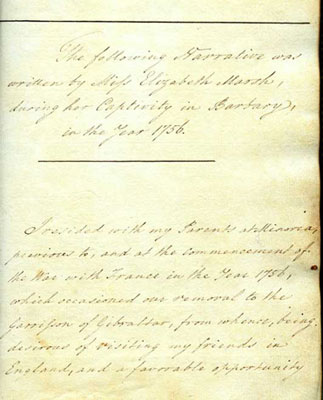
Elizabeth Marsh
(Mrs. Eliza Crisp). Narration … of her captivity
in Barbary, in the Year 1756. Manuscript.
[click
on image to enlarge]
|
A captivity narrative
by a middle-class Englishwoman, Elizabeth Marsh, whose ship
was attacked by Corsairs in 1756. She was taken to Morocco
where the Imperial Prince asked her to join his seraglio.
Like Bradley, she was fortunate enough to be ransomed by
the British government some months later.
|

wilder
shores exhibit home |
europe
| russia
| turkey
| the
middle east | india
and the far east | africa
| the
americas | credits
©
2007 by the Regents of the University of California. All rights
reserved. |
|
Wilder
Shores is organized geographically, loosely following the structure
of Barbara Hodgson’s book No Place for a Lady: Tales of Adventurous
Women Travelers. (Berkeley: Ten Speed Press, 2002). The exhibit features
books and manuscripts, both by and about, women who traveled to these
regions:
|
